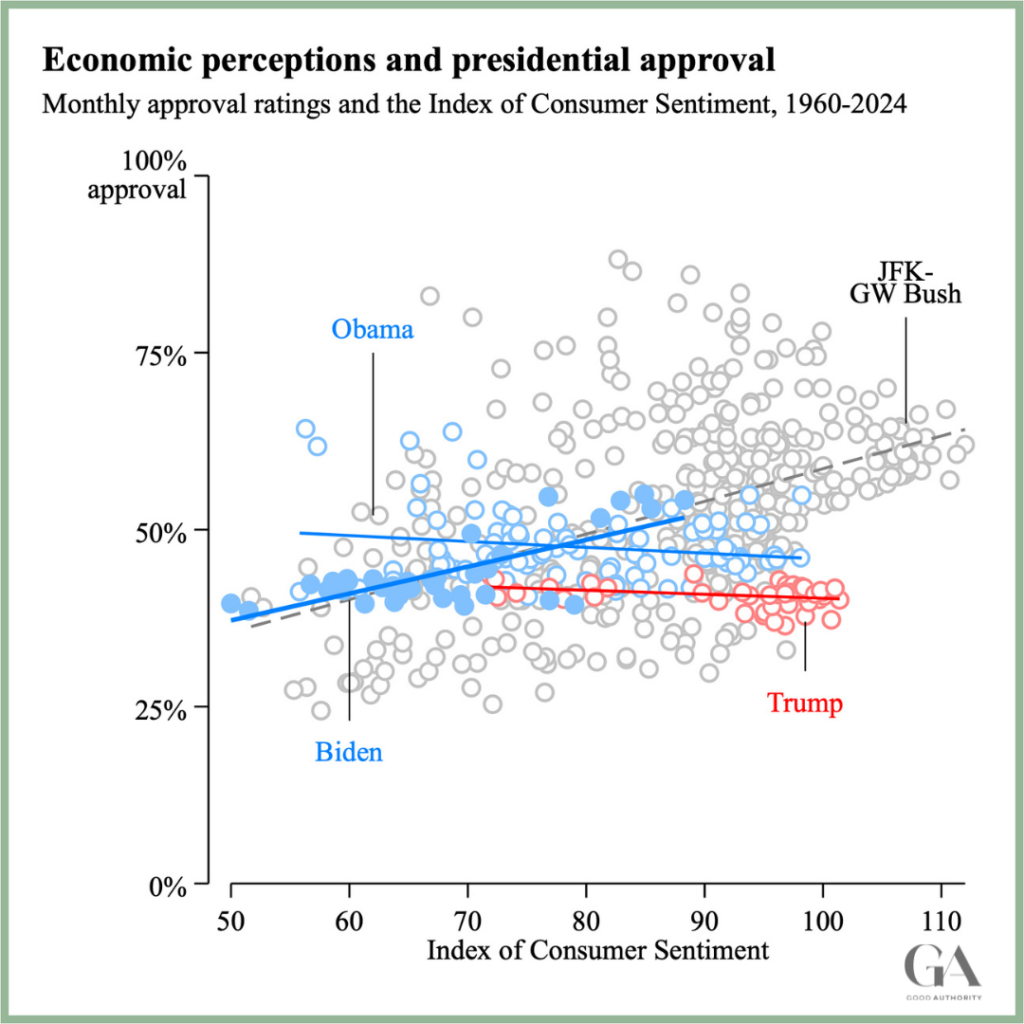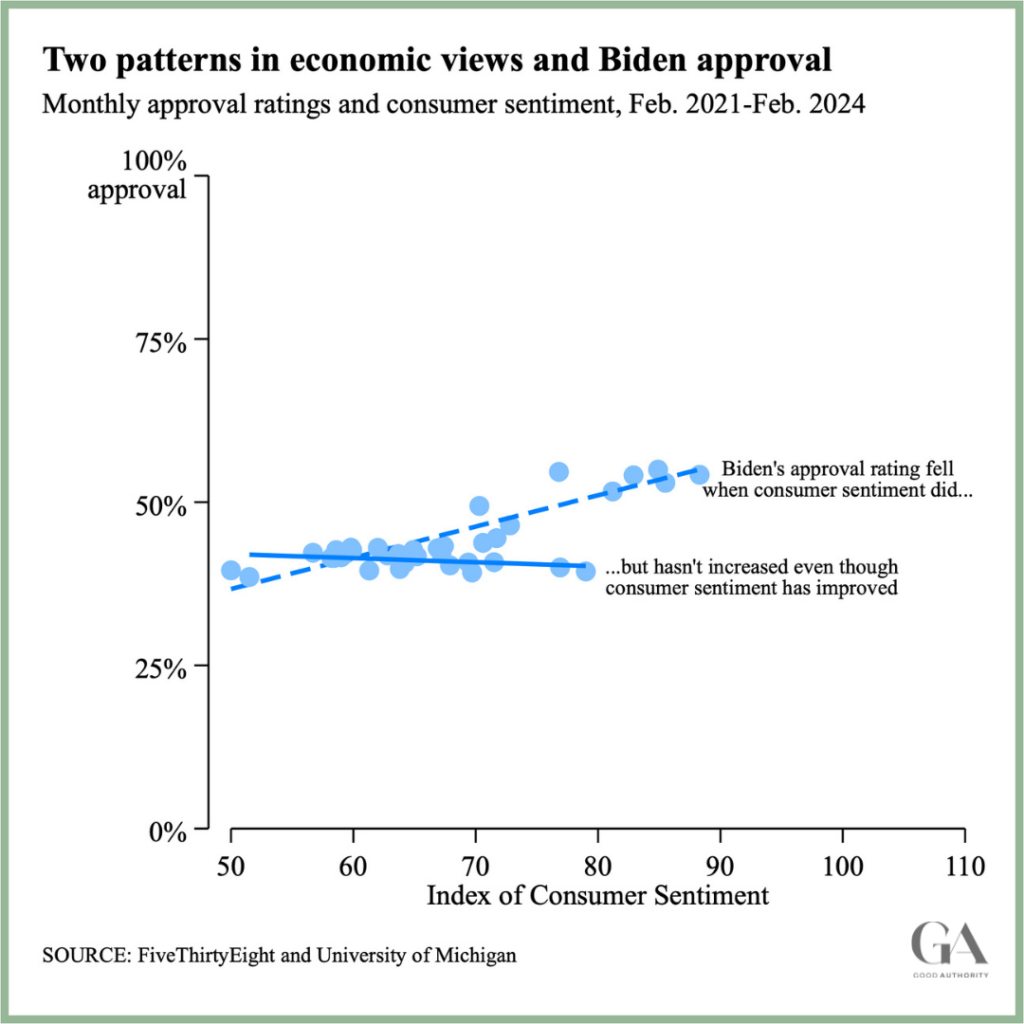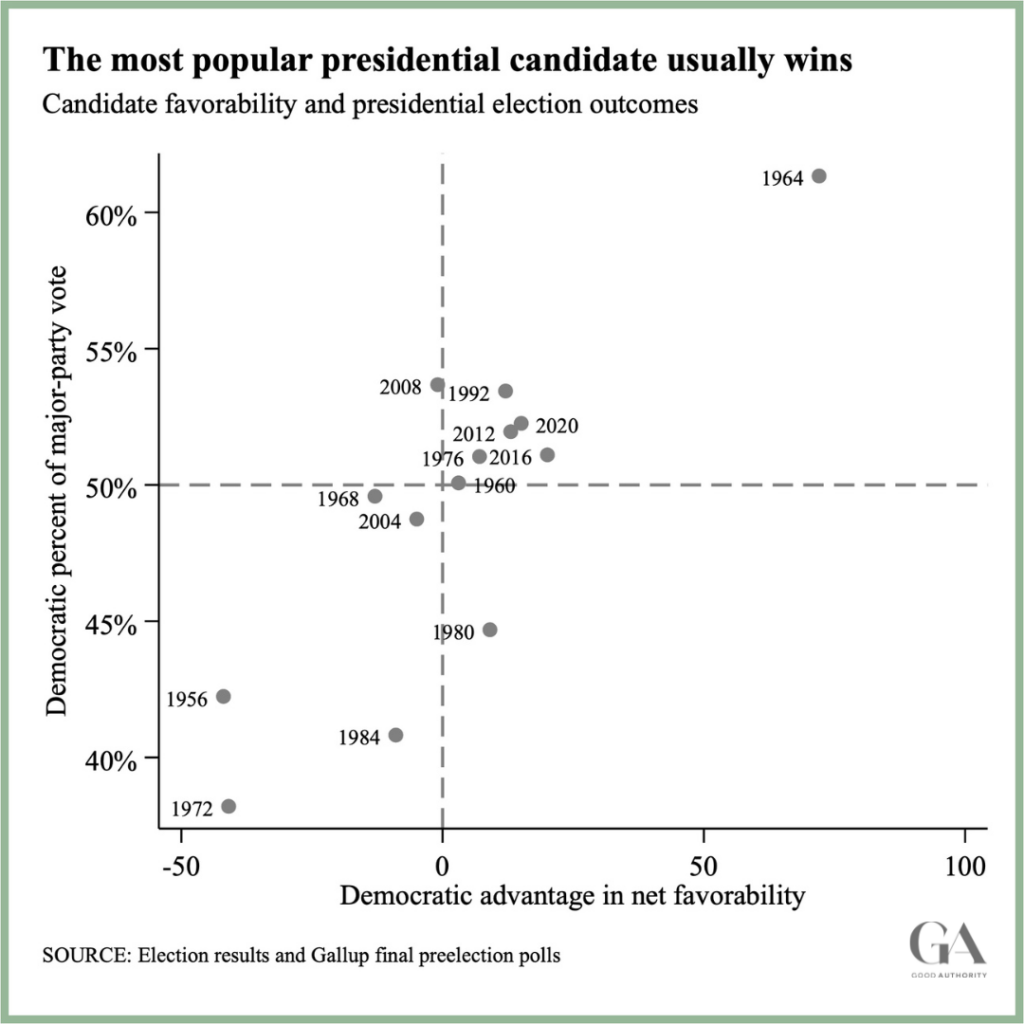A lot of people are nervous about Joe Biden’s chances of reelection. Maybe you’ve seen headlines like “Biden campaign works to ease Democratic anxiety over reelection chances” or “‘This Is Grim,’ One Democratic Pollster Says.” The special counsel’s report that said a jury would see Biden as “a sympathetic, well-meaning, elderly man with a poor memory” only occasioned more headlines, such as “Senate Dems privately fear Biden’s age could cost him White House.” There have even been calls for Biden to step aside and Democrats to pick a new nominee at their convention this summer.
But Biden and his closest advisors don’t seem that concerned. In an interview with the New Yorker’s Evan Osnos, Biden said: “We won every contested race out there. In 2024, I think you’re going to see the same thing.”
The challenge facing Biden is that he is simply not popular. But the election is still about nine months away. So how concerned should Democrats be? Let’s dive into some data. In this piece, we’ll show you these things:
- Biden’s approval rating today would forecast a 3-point loss in the national popular vote.
- There is precedent for presidents to see their approval rating increase in the election year. Whether Biden will experience this, however, is an open question.
- Biden is viewed less favorably than Trump – and this is also correlated with losing the election.
- A large fraction of voters say they dislike both candidates, but it’s not clear exactly who they will favor in the end.
Biden’s approval rating today – and what it would predict
At this early date, approval ratings actually predict the eventual outcome better than polls do – according to the book The Timeline of Presidential Elections by political scientists Robert Erikson and Christopher Wlezien. On average, about 38% of Americans approve of the job Biden is doing as president and 56% disapprove.
That’s obviously a low number. In net approval (the percent approve minus the percent disapprove), Biden’s rating puts him behind every single president since Harry Truman at this point in their term. His net approval is even lower than Trump’s was at this point in 2020.
If that 38% approval rating did not change between now and the summer, it would likely translate into a little over 48% of the two-party vote. This is based on the historical relationship between June presidential approval ratings and election outcomes between 1952-2020:

If you want to think about the forecast in terms of Biden’s margin against Trump, a 38% June approval rating would translate into about a 3-point loss for Biden. That is a little larger than the 1 to 2 point gap separating Biden and Trump in trial-heat poll averages.
Now, such a forecast is simplistic and comes with considerable uncertainty. Nevertheless, presidents with approval ratings this low in June during an election year have been likely to lose or see their parties lose.
Could Biden’s approval rating improve?
Biden supporters could find optimism in this trend, however: A president’s approval rating often increases in the election year. This happened to Richard Nixon in 1972, Bill Clinton in 1996, and, to a lesser extent, to Ronald Reagan in 1984, George W. Bush in 2004, and Barack Obama in 2012.
Indeed, even Donald Trump – who had famously low and stable approval ratings – saw a modest bump in his approval rating in March 2020 after he declared a national emergency because of covid-19. Of course, that bump dissipated in the spring as he shifted toward calling for a reopening of the country and harshly criticized the protests after the murder of George Floyd. An interesting counterfactual is whether Trump could have maintained that modestly higher approval rating had he acted differently. If so, he’d fit this pattern too.
Why Biden’s approval rating could improve
Now, should we expect this pattern for Biden? Here are some reasons to say yes.
By far the biggest reason is what we can call the low-hanging fruit: plenty of Democratic or Democratic-leaning groups that haven’t yet come home to Biden.
For example, in YouGov polls, about 85% of Democrats approve of Biden. In Gallup polls, it’s about 80%. At this point in Trump’s first term, his approval rating among Republicans was about 90% in YouGov polls and 92% in Gallup polls.
The same pattern shows up in vote choice. In Marquette Law School polls, 86% of Republicans back Trump, while only 79% of Democrats back Biden and 11% say “someone else.” Similarly, Biden is winning only 83% of his 2020 voters in the latest New York Times poll. Trump is winning 97% of his 2020 voters.
We’d expect Democratic voters to come around because campaigns tend to rally partisans or partisan-leaning groups to their party’s candidate. This is a venerable finding, dating back to early political science research on campaigns. Biden experienced exactly such a rally in 2020, as his favorability rating among Democrats increased by almost 20 points.
One way to simulate this is to push partisans in polls to say whether they lean toward Trump or Biden. Once the Marquette Law School polls did this, 93% of Republicans backed Trump and 90% of Democrats backed Biden. That’s the level of partisan loyalty we’d typically expect on Election Day.
Why Biden’s approval rating might not improve
The main reason to be less confident that Biden’s approval rating will improve? Thus far, his approval rating has been stubbornly low, even in the face of positive economic indicators.
In the first year and a half of his presidency, Biden’s approval rating tracked consumer sentiment pretty closely: As inflation rose and consumer sentiment dropped, so did Biden’s approval. Indeed, it looked as if Biden’s presidency might restore a relationship between approval and consumer sentiment that had disappeared under Obama and then Trump.
As of February 2024, some relationship still persists:

But the problem for Biden – as Seth Masket noted a few months ago – is that the graph above conceals two distinct patterns: Biden’s popularity fell alongside consumer sentiment but his popularity hasn’t recovered, even as consumer sentiment has become more positive since June 2022.

Some analysis has shown that it takes a while for consumers to forget inflation when they are evaluating the economy. It may be that it takes even longer for rising consumer sentiment to be reflected in Biden’s approval rating.
On the other hand, if Biden’s experience mirrors Trump’s or Obama’s, he may not see much of a lift from the improving economy. This too is a possible consequence of the “calcification” that Chris Tausanovitch, Lynn Vavreck, and I described in our book on the 2020 election, The Bitter End: Evaluations of presidents are more anchored in partisanship and less sensitive to changing economic conditions.
Trump is better liked than Biden
Of course, there are more factors in 2024 than Biden’s approval rating. There is, after all, his likely opponent, Donald J. Trump. The election may prove to be more about the choice between Biden and Trump than a referendum on Biden’s presidency alone.
The problem for Biden is that Trump seems more popular. Right now, 43% of Americans have a favorable view of Trump and 53% have an unfavorable view. Biden’s ratings are worse: 40% favorable and 55% unfavorable.
In the New Yorker interview, Biden advisor Jen O’Malley Dillon dismisses this: “Historically, favorability and vote choice have been correlated. I actually think that’s no longer the case.”
She is certainly correct about the history. Since 1956, Gallup’s final preelection poll has asked Americans to rate each major party presidential candidate on a 0 to 10 scale. The relative balance of favorable and unfavorable views is strongly correlated with voting.

In 15 of 17 cases the candidate viewed most favorably won. The main exception was 1980: Voters viewed Carter more favorably than Reagan but Carter still lost, arguably because people still disapproved of the job he was doing. In 2008, Obama was just 1 point behind McCain in favorability and won.
But perhaps we can’t learn much from historical elections. Right now, 2024 stands out for the large percentage of voters – roughly one in five – who have a negative view of both Biden and Trump. A deep dive into these voters by Charles Franklin, director of the Marquette Law School Poll, found that they are evenly divided between Democrats and Republicans. For this reason, the “double negative” voters have not consistently favored Biden or Trump, although they did lean toward Biden in the most recent Marquette Poll from mid-February.
The takeaway
In the New Yorker article, a senior Biden aide dismissed the polls showing Biden trailing Trump: “Polling is broken.” What is less easy to dismiss is that important voter attitudes do not favor Biden right now. At the same time, Biden’s situation could improve, as it did for other incumbent presidents.
He has just over 7 months between now and November 5.



